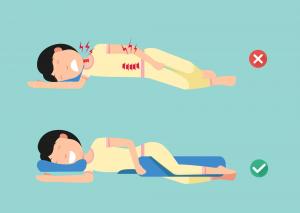Sleep & Health

Waking up with shoulder pain?
It’s been repeated time and time again that the best sleeping position for shoulder pain is on your back. It helps promote proper spinal alignment and helps reduce pressure on joints. That does not mean everyone is going to be able to switch to this position, though. For those 74% of people who prefer side sleeping, they want to make sure they are having a comfortable experience throughout the night.
One of the biggest complaints is arm and shoulder pain from sleeping. In fact, 67% of those who sleep on their side complain of shoulder pain on the same side. Fortunately, there are ways to alleviate some of the arm and shoulder pain from sleeping.
1. Find the right mattress
You spend a third of your life asleep. Your mattress is the biggest component to help you get a great night’s sleep. As a side sleeper, you can experience more arm pain after sleeping on your side. A plusher mattress can conform to your body and provide pressure relief. The softer surface helps the hips and shoulders sink more into the mattress, alleviating some of the shoulder pain you may experience throughout the night. At BedMart, we carry a variety of soft and medium soft mattresses available in all sizes that can accommodate side sleepers’ needs.
2. Relieve joint pressure with pillows
Pillows can make your sleep environment even comfier. They can also help relieve any pressure you are putting on your joints. You can use a pillow to elevate your legs or keep your arms from going slack while asleep. This can help prevent shoulder pain and prevent too much pressure on your spine, shoulder and arm while side sleeping. Some people may even try to use pillows to help prevent them to change to their side during the night. If you are concerned about rolling over and laying on your shoulder, place a pillow in a way that prevents you from sleeping on your side.
3. Sleep on left side
The side you sleep on matters. Why does this matter? It’s better to sleep on your left side because of your organ placement. Your stomach is naturally placed on the left, so being a optimal position for gastric health helps you properly digest throughout the night. It also can assist with healthy blood flow and prevent acid reflux. So, if you sleep on your side, the best side is your left.
4. Don’t sleep on your arm
Even though many side sleepers may love it, sleeping with your arm under your pillow is a big no no. It can cause additional pain and numbness from the pressure you are putting on your arm and shoulder. People who tend to do this are more prone to arm pain from sleeping on their side. If you find yourself sleeping in this position, it is probably your pillow not providing the correct amount of support. Your body wants to have proper alignment and sometimes your instincts try to correct it. Make sure you have the proper pillow so you can give your arm a break.
5. Do morning stretches
Side sleeping is a common position because it resembles the fetal position held within the womb. It brings us comfort. However, this position can cause a rounded back and shoulder as you relax into a deep sleep. In the morning, you might wake up with stiff muscles and joints from the awkward positioning, so take time for a quick stretch. Find a few stretches for your arms, hips and legs to help loosen and wake up your body every morning. It’s important to get your blood flowing and loosen your joints. Here is an easy stretch to try in the morning.
– Reach to the sky for 20 seconds.
– Bend over and try to touch your toes for 20 seconds.
– Reach with your right arm and try to touch your left foot. Hold for 20 seconds. Repeat with the opposite side.
– Pull your arm across your chest and hold for 20 seconds and then switch.
The Pros and Cons of Side Sleeping
There are a number of pros and cons to sleeping on your side. Even though back sleeping is known as the best sleeping position, sleeping on your side can have its own set of benefits. Side sleeping can help people with snoring issues and sleep apnea because it helps open up your airways. It is also a great option for women who are pregnant because it helps with breathing and also so doesn’t put pressure on the belly. It has been shown that sleeping on your left side can aide with digestion because the position helps with the system to flow properly and prevents issues such as GERD and bloating. Also if done correctly, you can reduce back and joint pressure.
With its advantages, there are also downfalls to sleeping on your side. It can cause you to have arm pain from sleeping on your side or wake up to a numb arm. Side sleepers restrict blood flow to their arms and put pressure on their nerves. This actually reduces your quality of sleep because every time this happens you wake up just enough to move into a more comfortable position.
Best Mattresses for Side Sleepers
When shopping for a mattress, you need to focus on finding something that provides proper support and comfort. Side sleepers tend to have arm pain from sleeping on their side when sleeping on a firmer mattress. It is recommended that you use a medium to medium soft mattress so it can conform better to your sleeping position and provide pressure relief. Memory foam mattresses are a great option because they are designed to contour to your body’s natural shape and promote proper spinal alignment. If you are interested in innerspring mattress, our Eastman House collection has a selection of beds constructed to be gentler on your hips and shoulders, so you don’t experience shoulder pain from sleeping.
Best Pillows for Side Sleepers
Your pillow plays a key role in helping maintain proper alignment and also ease pressure throughout the night. Selecting the correct pillow can help support your neck, head and spine so the natural curve is maintained. Make sure you try out different pillows to help find the perfect fit for your needs. If the pillow has too much height or is too flat it can cause muscle strain. For side sleepers, you will need a pillow that can help lessen shoulder pain at night. The ideal pillow for side sleepers is one that will allow you to adjust positions throughout the night. Some people may even need two pillows to help with alignment and comfort.
